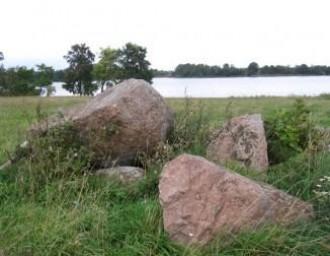Belarus has its own Stonehenge

Heaps of field stones scattered intricately along the meadow. If you don’t know beforehand – you’ll hardly guess why they are located in such a strange way…
After reading the book “Tacit witnesses of the past” by Ernst Levkov the fact that Belarus has its own variant of famous Stonehenge – field stones oriented towards the sides of the sun – I was intended to visit the religious place. The stones are situated not far away from the Bikulnici village, hundred metres from Lake Janovo. It is northern part of Belarus, twenty kilometers to the south of Polotsk.
The fact that the field stones lie somewhat strange was first noted by the participants of the geological expedition in the august of 1987. The stones are laid in such a way that they form an almost straight letter “U”. Each of their sides had an equal length of around 15 meters. The figure also reminded a huge square without one side.

Geologists immediately took notice of the peculiarities of the stone composition. The sides of the figure were oriented at the cardinal points is such a way that the letter “U” looked onto the northwest with its exposed part. The side lines of the figure were vectored in the same direction. The detail that cannot pass unnoticed: if you stand in the center of the stone letter and look to the side where it is open, then just on the opposite side of the lake there lies a butte. It is the most noticeable point in the neighborhood, its command over the lake is about 25 meters. The hill is called Mount Volotovka.

“According to all the signs, the traces of an ancient building connected with celebration of the summer solstice are left near the Bikulnici village, - the geologist Ernst Levkov writes in his book “Tacit witnesses of the past”. – Most probably that it was here where the heathen temple of the deity which, according to some historians and ethnologists, was named Kupala, was situated. Ivan Kupala festivities are the contemporary echo of the ancient heathen beliefs”.

The expert has his proofs for such an interpretation: the presence of the lake named Janovo (i.e. Ivanovo), northwestern orientation of the construction, the warm reddish-pink coloring of the field stones and even the location of Mount Volotovka, where local people make fires at Kupalle to this day.

Probably the peaked hill served as a landmark. When the sun set behind it, it was a signal for the observers that were on the opposite lakeside. The signal that fixed the moment of the summer solstice and the celebration of the Kupalle night.

By the way, at the center of Stonehenge there is also a “U”-like figure, only it is oriented towards the northeast. It was important for the people of Britain to determine the coming of the longest day. One of the versions about the purpose of the Stonehenge suggested by Gerald Hawkins in 1965 says that the entire huge stone complex is the unique laboratory of the ancients for the conduction of various astronomic observations. For instance, on the Midsummer Day in the middle of the circle one can see how the sun rises just above the Heel Stone, or the fifth stone of the Stonehenge. In the case of Belarus we had to determine the time of the night arrival, and it prompted to turn all the construction to the west.

In ancient times the neighborhood of Lake Janovo belonged to the Duchy of Polotsk. In its time it was not only the strongest on Belarusan soil but also one of the most powerful among the Eastern Slavs. As far back as the middle of the 11th century in loco of the wooden church in Polotsk the Saint Sophia Cathedral was built, an influential religious center spreading Christianity on the territory of Polotsk. It is quite natural that in such situation the heathen temple in the center of the Duchy and in the neighborhood of the capital city was no longer in force.

-
03.01
-
07.10
-
22.09
-
17.08
-
12.08
-
30.09



























